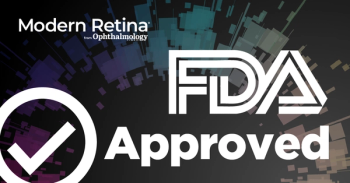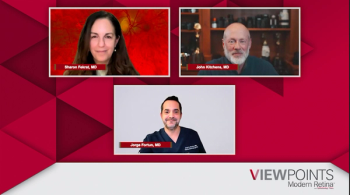
Eichenbaum Acorns: Inside the mindset of an early adopter with Jordan M. Graff, MD, FACS
For Jordan M. Graff, MD, FACS, early adoption is about reigniting the thrill of discovery and navigating the rewards, risks, and realities of translating innovation into practice.
Eichenbaum Acorns is an editorially independent series powered by Modern Retina® and hosted by David A. Eichenbaum, MD, FASRS, partner and director of research at Retina Vitreous Associates of Florida in Tampa. This Q&A-style article and podcast series explore the overlooked corners of the retina specialist profession through candid conversations with thought leaders. Eichenbaum is the German translation for oak tree, and the aim of this series is to plant acorns of insight that grow into oaks of understanding.
In this installment, Eichenbaum chats with Jordan M. Graff, MD, FACS, of Barnet Dulaney Perkins Eye Center in Phoenix, Arizona, to discuss the realities of early adoption in retina care. Graff’s experience with the port delivery system (PDS) (Susvimo; Genentech), first as an investigator and later as one of the most active commercial utilizers in the US, provides insight into the opportunities and challenges of early adoption. He has navigated both the initial excitement of innovation and the realities of setbacks, including Genentech’s October 2022 voluntary recall following septum dislodgement issues. With the July 2024 reintroduction of a revised product, Graff offers a perspective on resuming adoption post-recall.1-3
Note: This transcript has been edited for clarity and length.
David A. Eichenbaum, MD, FASRS: Let’s start with the why. Why did you choose to adopt this new technology? What about it spoke to you?
Jordan M. Graff, MD, FACS: For me, perhaps with the [PDS] and a decade in clinical research, also [my involvement] in the gene therapy trials and the new medications…faricimab and some of the things that are happening right now that we’re all involved in, I think the [PDS] was right about at that time, about a decade ago. I’m 6 years into practice [at that time], and I’m finding I love my practice. I’ve got my groove. I’m comfortable in the [operating room]. I’m comfortable with my clinic, and I’m feeling that I was lacking some of what I loved about education. You’re going through residency and learning new techniques, and every cataract surgery is new, every glaucoma surgery is new, every technique is new, and you’re excited. I was feeling I want to feel challenged. I want to try something new. I want to see what the next generation is, because during my residency, anti-VEGF came out, and we watched that whole revolution take place. That spoke to me to reinvigorate that feeling of discovery.
Eichenbaum: You then made the leap from being a busy trialist to becoming an early adopter of the PDS in real-world practice. What was your why?
Graff: I saw the process of evolution, and it was fun to be a part of that. The port delivery platform has the potential to be one of those products that allows us to deliver an unlimited imagined molecules in sustained delivery if we can get better and better at the surgery. I saw the challenge of early adopters of [phacoemulsification (phaco)]. I saw the challenges of early adopters of minimally invasive glaucoma surgery (MIGS). The early phacos were not great, and the pseudophakic bullous keratopathy was a big issue. The early MIGS were not ideal, but they got better and better at it because they saw a potential future. I think that a lot of things we’re involved in in trials, once they go commercial, if we get really good at this and we drop those complication rates dramatically, we could see the potential application be even broader.
Eichenbaum: What were the pain points or what did you learn by being an early commercial adopter?
Graff: One of the early pain points was to have the first iteration, to see a percentage rising of the septum dislodgement, and think, “I really invested in this. I’m excited about it. I think I’ve been telling people about it,” and to realize that we had to voluntary withdraw, and…pause. I knew there would be some changes in adoptions, but I didn’t think it would mean a total pause in implantation. That makes you cautious. It makes you concerned. That process has been challenging.
Eichenbaum: Did you see septum dislodgements in your commercial patients on the first iteration?
Graff: No, but I did have a couple of patients with the first version of the implant who in study had a septum dislodgement. What was reassuring was the patients’ energy, because I could feed off that when I was feeling down. To the patients, I said, “Well, we could leave this in there; we could take it out and sew it up; or we could put a new one in.” Both of my patients were like, “Are you kidding me? This is great. Just put in a new one.”
The sponsor was very good to work with. And that they did a voluntary withdrawal without waiting for some kind of FDA mandate or serious complications to happen— that support made you feel like you weren’t alone.
Eichenbaum: Tell me about the big commercial wins. What experiences have encouraged you to keep moving forward?
Graff: It does come back to the patient’s energy and enthusiasm. There’s this sense with patients who have been getting injections for years, and now they’re coming in every 8 weeks instead. Maybe before they had more active lesions that required treatment every 6 or 8 weeks. Now, with the implant, I still bring them back for follow-ups—partly to check on them, since there’s still about a 1.6% risk of erosion. It’s low, but not zero, and there are occasional revisions. The patients call those visits their “smug appointments.” They’re sitting in the waiting room, and there’s this kind of dialogue. One patient leans over and says, “Here for your injection?” The other replies, “Yeah. You?” “Every 8 weeks.” “I’m at 9.” And then the person in the middle says, “Oh, I used to get those.” And the others go, “Wait—what?”
Eichenbaum: How has the community responded over the past year since the relaunch? People now recognize that you are one of the pioneers performing these procedures. What has that experience been like from the perspective of being the person who puts them in?
Graff: It is fun to connect with friends and colleagues who we see in the meetings from the other side of the country. We end up talking about what we’ve done in clinical research, what’s coming down the pike, and what we’re doing commercially. You get all of these water cooler conversations that are fun. Every once in a while, you’ll get a naysayer, and that’s all right; it’s a healthy discussion. The same kind of thing happened early with phaco. Anything that stretches is going to bring questions. That’s a good thing, that debate is healthy.
Eichenbaum: What advice would you give to retina specialists—particularly those earlier in their careers—who are inspired by your experience with the PDS and are eager to be early adopters of the next major innovation?
Graff: I would suggest if you’re able to get involved in clinical trials, that’s one of the best ways to see things early on. That helps if you’re able to see what’s coming down the pike next.
Second, I would reach out to a friend, colleague, associate, or an acquaintance you respect. Great business minds do this. We don’t do it enough in medicine. We silo ourselves. Pride gets in the way. Great business leaders and great entrepreneurs reach out to those who they respect and get their insights and ideas. Getting some kind of a mentor would help.
Third, go for it. Try it. There’s nothing like the opportunity. For something like the [PDS], there’s such a robust preparatory process that helps you feel readily prepared when you first adopted.
Eichenbaum: For physicians considering early adoption of new technologies, what are the practical realities of discussing and managing the increased out-of-pocket costs for patients?
Graff: That can be challenging. I know all of us in our practices deal with this. It’s a reality of our practice today—whether it’s dealing with high-cost drugs that we used to have easier access to through co-pay assistance, but no longer do, or adopting new technologies, such as the upcoming TKIs [tyrosine kinase inhibitors], gene therapies, intraocular biofactories, or the currently available [PDS].
I initiate this conversation with the patient by saying that insurance will cover some of the costs, thankfully, but probably not all. I don’t know every nuance of insurance, but I do know there will likely be some financial responsibility on their part. My practice manager or team lead then goes over the exact numbers with them.
I tell patients that the medical decision is mine to help guide, but the personal decision about whether it’s worth it for them financially is theirs. I provide answers about the medical benefits, burden reduction, and safety so they can make informed choices. Until they have that information, it’s difficult for them to assess the value of what they’re receiving.
Eichenbaum: You and I are both pipeline folks. What excites you the most? What could be the next breakthrough for you, me, or someone else in the community to take the lead as an early adopter?
Graff: The data coming forth on the TKI as a burden reduction and a safe opportunity looks promising. One of the several intraocular biofactory gene therapies—the data are looking promising. We’re probably soonest to get subretinal delivery based on the way those trials are going. Although I wonder, long term, if subretinal delivery is going to be the way to do that as we look at the new molecules being studied with 4DMT and suprachoroidal delivery. I’m interested in seeing where intraocular biofactory will be easily adopted.
I’m equally interested in the next step of what’s coming down the pike in port delivery as a platform to see in the ongoing studies, including surgical modification to reduce and simplify the surgery and delivery of faricimab-like molecule. I’m excited to see where that would go, where this platform has 9 to 12 months of extension treatment and new drugs to be available.
Eichenbaum: It’s amazing the technology we have in the late phase now. It’s true that drug development is fraught with failure, but the probability of failure does decrease as drugs advance. All these programs have different nuances, how they got to phase 3, and have some variability in their end points. We are in a remarkable environment now with amazing innovation in development, and I’m envious of our colleagues in training and what they will see over the next 40 to 50 years. New trainees have a lot to learn—more than when we were training—but that’s the benefit. Retina is a special place to build a career, which is pretty fantastic. Thank you for joining me, Jordan.
David A. Eichenbaum, MD, FASRS
E: deichenbaum@rvaf.com
Eichenbaum is a partner and director of research at Retina Vitreous Associates of Florida, and a collaborative associate professor at Morsani College of Medicine at the University of South Florida in Tampa. He has no relevant disclosures.
Jordan M. Graff, MD, FACS
E: jgraff@bdpec.com
Graff is the chair of the Division of Ophthalmology at Creighton University; a clinical assistant professor at the University of Arizona in Phoenix; a surgeon and partner at Barnet Dulaney Perkins Eye Center at American Vision Partners (AVP); and chairman of the Medical Executive Committee of AVP in Phoenix. Graff reports disclosures with 4DMT, Adverum Biotechnologies, Apellis Pharmaceuticals, Hi-Health, Iveric Bio, Kyowa Kirin, Ocular Therapeutix, Ollin Biosciences, Regeneron Pharmaceuticals, RegenxBio, and Roche/Genentech.
REFERENCES
Genentech to reintroduce Susvimo for people with wet age-related macular degeneration (AMD). News release. Genentech. July 8, 2024. Accessed August 20, 2025.
https://www.gene.com/media/press-releases/15031/2024-07-08/genentech-to-reintroduce-susvimo-for-peo Update on Susvimo ocular implants voluntarily recalled in October 2022 - potential to affect the refill-exchange procedure. Genentech. March 2025. Accessed August 20, 2025.
https://www.gene.com/download/pdf/Susvimo_DHCP_Important-Prescribing-Information_March2025.pdf Rachitskaya A, Graff J. Key steps in the surgical implantation of the port delivery system. Ophthalmology Times Europe. January 29, 2025. August 20, 2025.
https://europe.ophthalmologytimes.com/view/key-steps-in-the-surgical-implantation-of-the-port-delivery-system
Newsletter
Keep your retina practice on the forefront—subscribe for expert analysis and emerging trends in retinal disease management.















































